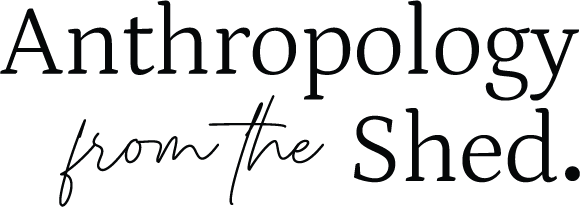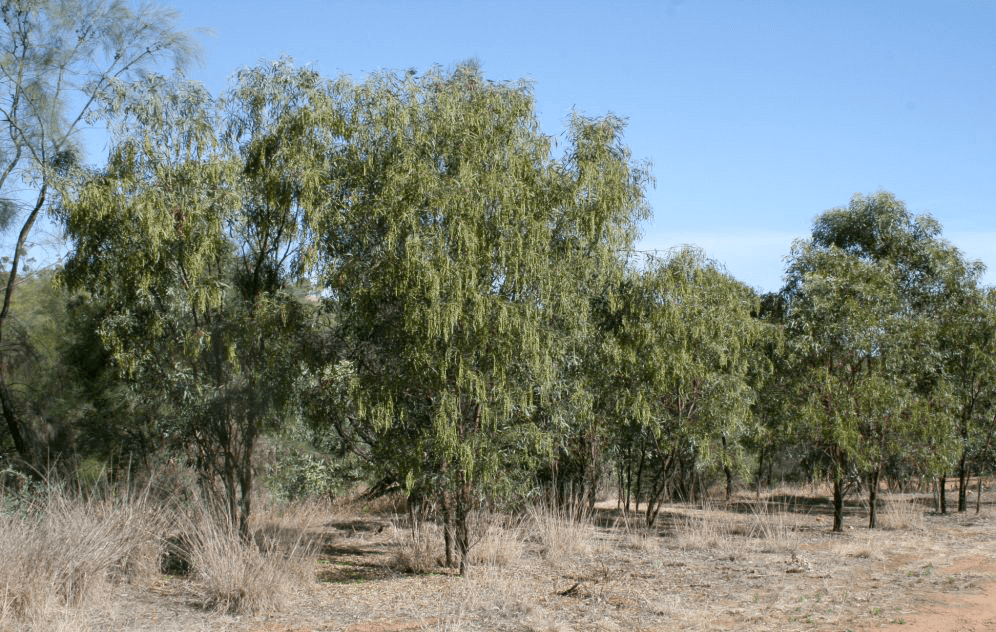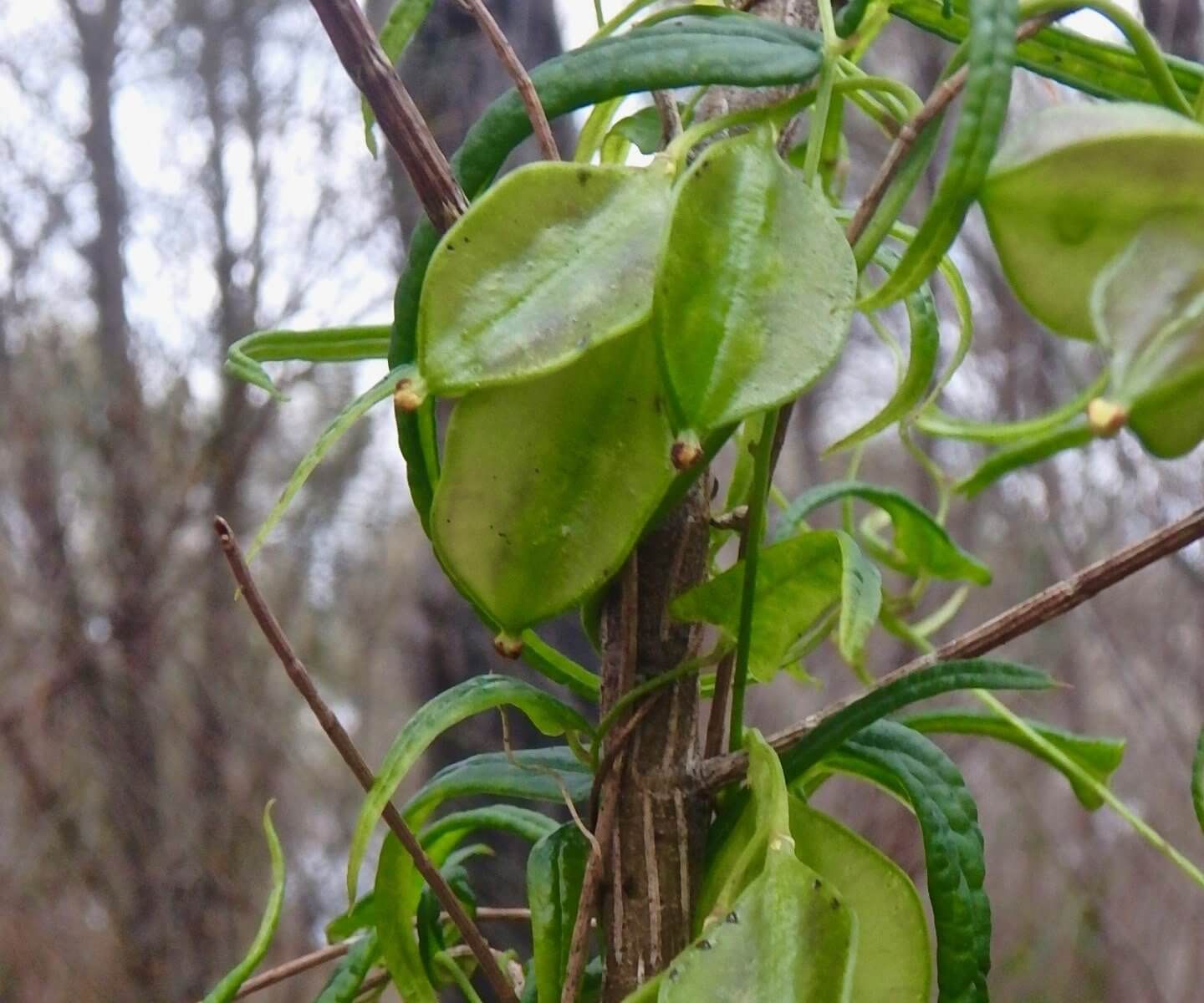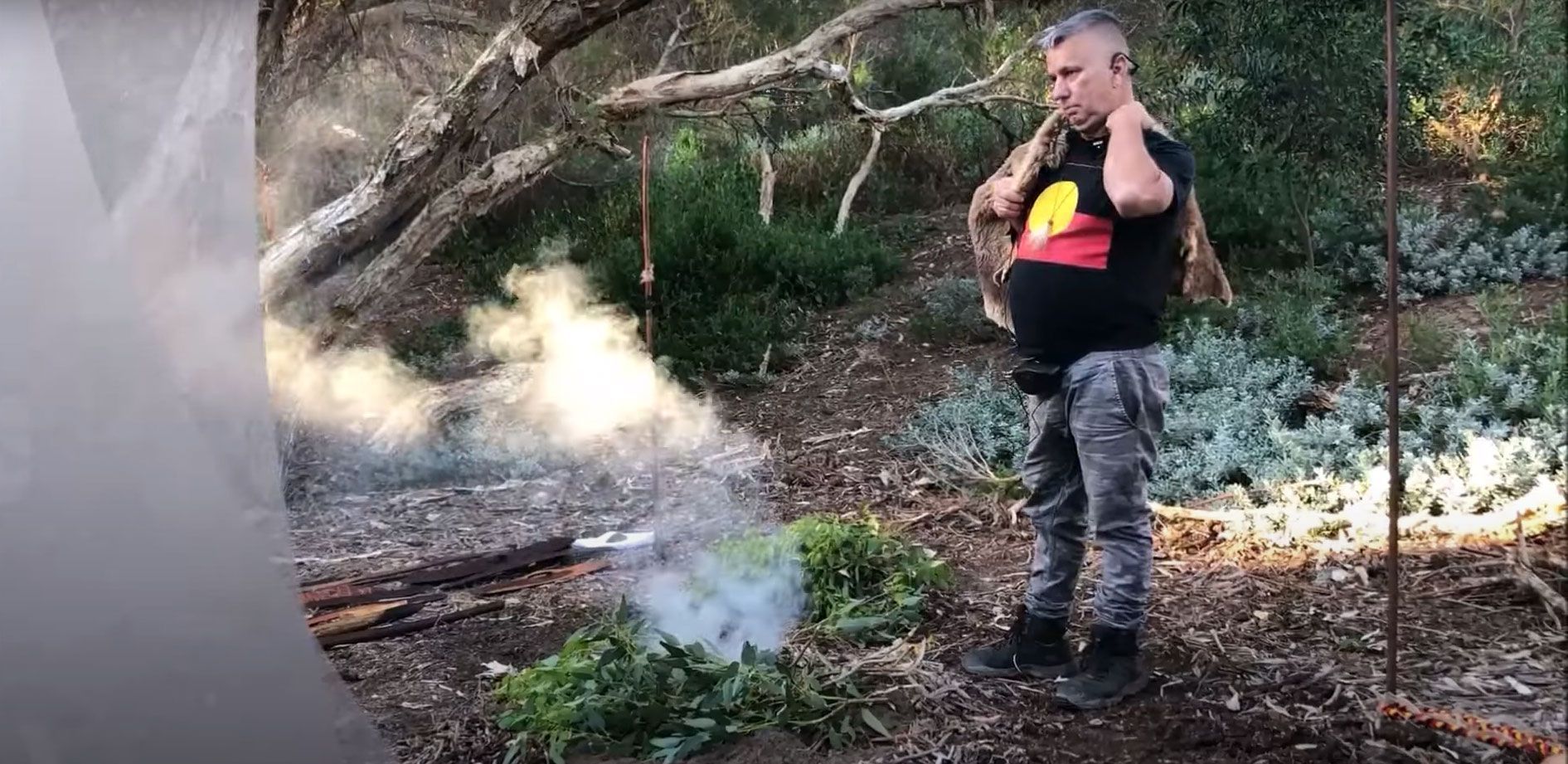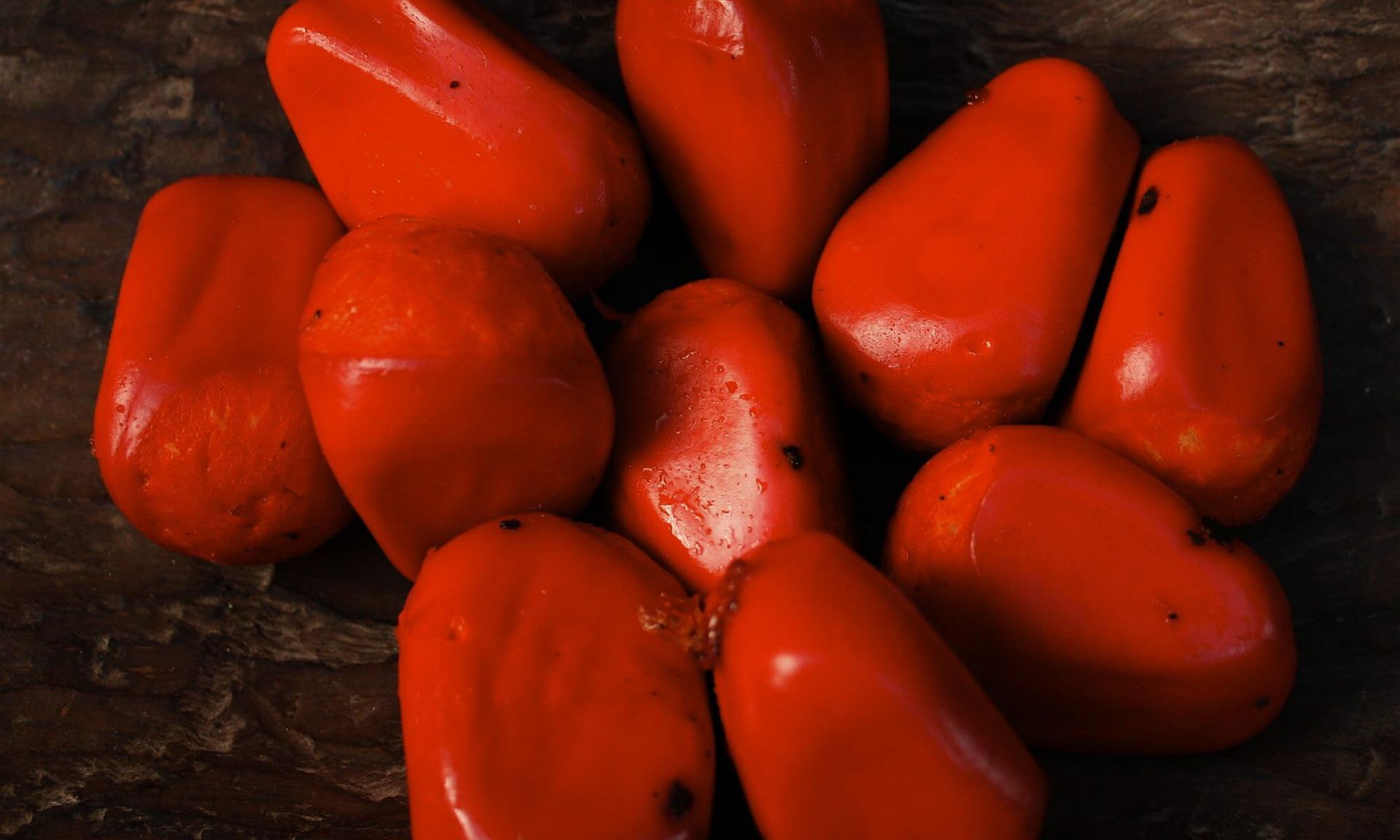Root Bark Eating in Southwestern Australia
By research anthropologists Ken Macintyre and Barb Dobson
Root bark is a little understood bush tucker that was once consumed by the indigenous Nyoongar people of inland southwestern Australia.1 The bark was collected to extract nutritious plant sugars found in the inner bark and vascular cambium of the roots of certain species of Eucalyptus trees. The living inner bark and vascular tissue forms a thin actively dividing layer of gelatinous sweet cellular tissue that separates the bark from sapwood. It is responsible for transporting sugars and other organic substances to all parts of woody shrubs and trees.
Only a handful of anecdotal accounts allude to this form of comestible among the traditional inhabitants of southwestern Australia (Drummond 1839, 1843, Grey 1840, Moore 1842, Ketoun 1849, Salvado 1851 and Bates 1938). James Drummond, the Colonial Botanist, in a letter to Sir William Hooker in 1839 was the first to record indigenous root bark eating.2 He states:
‘The Eucalyptus found on the sandy loam, is called by the settlers York Gum, by the natives Doalta;3 they use the bark of the root as food in the dry season chewing it along with the gum of the Manna.’4
Drummond (1839) states that it was chewed ‘until they separate the saccharine matter which the root contains.’ They then ‘spit out the refuse, which is generally to be seen near their bivouacs.’5
Grey (1840:117) records tdowt-ta as ‘a root eaten by the natives.’ He clearly did not observe the tree first-hand as he provides no identifying names or details and does not include any reference to the consumption of root bark. It was the root bark, not the root, of the tdowt-ta that was eaten.
Both Moore (1842: 97) and Drummond (1839) identify twotta or doatta as York Gum (Eucalyptus loxophleba). Moore (1842: 70) states:
‘A Eucalyptus, of which the natives chew the bark of the roots, wrapped about gum, or pounded up with it into a cake. Colonially, the York gum-tree, being the principal timber which characterizes that district. The lands whereon it is found are generally good for sheep pasture.’
Bishop Salvado (1851), in his memoirs, records Duotta as ‘the roots of certain types of trees’ but he does not name these trees. He comments:
‘The fibrous outer covering of the roots of certain types of trees forms one of their food-stuffs. They heat it over the fire and crush it, and then eat it with gum. Normally they suck the substance out of it and spit out the residue.’ (Salvado in Stormon 1977: 161)
‘The outside tegument of the roots of this tree forms one of the native foods; they scorch and grind it, and then chew it and spit out the residue.’ (Salvado in Storman 1977: 212).
Storman (1977: 212, 294) when interpreting Salvado’s work makes an assumption (based on the phonetic resemblance between duotta, dward and tuart) that the tree being referred to by Salvado is the tuart (Eucalyptus gomphocephala). However, it is our view that Salvado’s description of duotta matches the wandoo (Eucalyptus wandoo) because he describes the white trunk of the tree, notes its susceptibility to termites and its usefulness as a water reservoir in the dry months- all of which are features of the white gum or wandoo. Salvado’s description of duotta is as follows:
‘…a species of eucalypt of which the wood is white, and extremely hard, but particularly subject to white ants… The hollow parts of these trees often retain supplies of rainwater from the winter months till summer; and the native make it squirt out by boring a hole through one of the knots of the trunk, and quenching their thirst as at a clear fountain, afterwards blocking up the hole to preserve the water for later on. I have often drunk this way, and found the water fresh but not very palatable. The outside tegument of the root of this tree forms one of the native foods; they scorch and grind it, and then chew it and spit out the residue. Moreover, they find in these roots certain yellow worms, as long as a man’s index finger, and they eat these in the way earlier described.’ (Salvado 1857 in Stormon 1977: 212)
For further details on the Noongar consumption of bardi grubs found in tree roots and trunks, see our paper at https://anthropologyfromtheshed.com/project/the-bardi-grub-in-nyungar-culture/.

Eucalyptus wandoo is unique in that it has the same scientific species name, common name and Nyoongar name. Very rarely are Nyoongar names incorporated into the Latin based Linnaean binomial nomenclature. It is our opinion that Stormon (1977:294) may have erroneously interpreted Salvado’s duotta as meaning tuart when in fact Salvado was probably describing the wandoo.6 Bird and Beeck (1988: 118) refer to the indigenous chewing of the roots of both dward (Eucalpytus loxophleba or York gum) and wornd (Eucalyptus wandoo or wandoo). They state that at the time of their fieldwork they:
‘collected wandoo or white gum roots which turned out to be very dry and unpalatable. This was attributed to the fact that the tree was growing on laterite gravel rather than sandy ground’ (Bird and Beeck 1988: 119).
What Bird and Beeck (1988) do not consider is that it was the root bark, rather than the root, that was chewed, and usually only after considerable processing. Bird and Beeck (1988) include the roots of Eucalyptus wandoo in their list of foods consumed by the inland Nyungars of lower southwestern Australia, based on the information provided by one of their senior Aboriginal informants. However, apart from noting that these were eaten in season, they do not provide any details as to when or how the roots (or root bark) were procured, prepared or consumed.7
The few fragments of ethnographic information provided by Drummond (1839,1843), Moore (1842) and Salvado (1851) when collectively analysed suggest that the root bark of at least two species of Eucalyptus was consumed. These were Eucalyptus loxophleba (the York gum) known by Drummond and Moore as ‘doalta,,’ ‘doatta’ or ‘twotta’ and Eucalyptus wandoo (what Salvado calls ‘duotta’).8 Both are inland Eucalyptus species that often co-exist within the same locality but in different soil types. Drummond (1839) points out that the York gum is found in alluvial ‘sandy loam’ whereas the white gum or wandoo is generally found in ‘hard clay.’ Like his contemporaries, Drummond fails to give any precise time, place or contextual description for indigenous root bark eating, except to say that it was eaten during ‘the dry season’.
Traditional Nyoongars were expert plant phenologists and fully aware of the seasonal timing and availability of fruits, seeds, flowers and roots, including the edible vascular cambium of the root bark of twotta Eucalyptus. It is our view, based on rudimentary iodine testing experiments of samples of twotta that this food would have been high in photosynthates (plant sugars) at the time of its collection and that it would have been relatively easy to procure using digging stick or wanna technology.
The fresh gum exudates found on Acacia species (most notably Acacia microbotrya) were added to the root bark chew. Sweet edible wattle gum known by Nyoongars as galyang or menna, to this day continues to be highly prized and sought after as a natural indigenous confection.9
Acacia microbotrya (colonially known as’ manna wattle’) often grows in the vicinity of Eucalyptus loxophleba (York gum) and can still be seen amongst remnant vegetation on the road verge near Drummond’s original property at Hawthornden, Toodyay. One could speculate that Drummond’s account of this practice of root bark consumption related to indigenous practice in the Toodyay district and its surrounds.
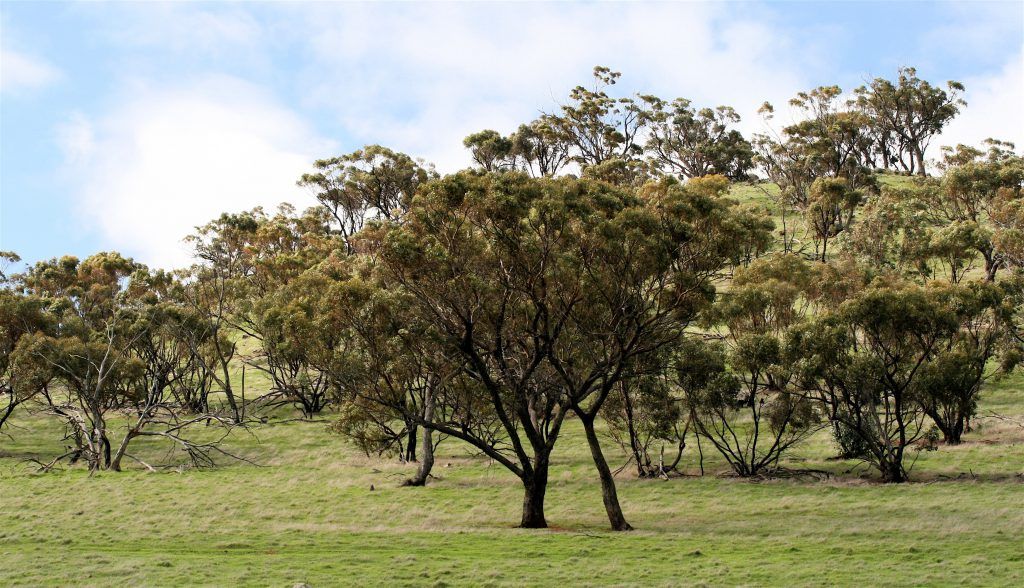
The early colonial records provide little insight into the methods used by indigenous inhabitants to collect and prepare root bark. However, it is possible using anthropological imagination and examples of ethno-historical descriptions of Nyoongar root-gathering activities to reconstruct a picture of the process of root bark procurement and its preparation for consumption. Classic examples of root gathering and processing involved seasonal staples such as yanjet (Typha domingensis), warrain (Dioscorea hastifolia or native yam) and bohrn, mein, or madje (Haemodorum or “bloodroots”). The digging of these rhizomes, tubers, corms and bulbs (or “vegetable roots”) was customarily the work of women. It would seem logical to assume that the collecting and processing of root bark was also a primarily female task.
Ketoun (1849) refers to Aboriginal women bringing him some gum and ‘twotta’ when food was scarce during his expedition from Toodyay to Wongan Hills in April 1844 (see Ketoun’s diary entries which are cited later in this paper). The procurement of root bark would have involved laborious digging to excavate the roots using a wanna which is a long hardwood crowbar (with a fire hardened point) rounded on one side and flattened on the other. Commonly referred to as ‘the digging stick’ the wanna was an indispensable tool – sometimes weapon – which was individually manufactured, maintained and carried by its female user. 10
Grey (1841:292-293) describes how Nyoongar women dug up roots using their wannas:
‘It is generally considered the province of women to dig roots, and for this purpose they carry a long pointed stick, which is held in the right hand, and driven firmly into the ground, where it is shaken, so as to loosen the earth, which is scooped up and thrown out with the fingers of the left hand, and in this manner they dig with great rapidity.’
Moore (1842: 24) provides a linguistic meaning for the above process, calling it:
‘dtanbarrang-ijow – to dig up; to dig out. A compound word, signifying literally, pierce (the ground), take (it; whatever is dug up, in your hand), put (it on one side), this being an exact description of the native style of digging.’
Root bark would have been simply removed by lifting the bark with the sharpened end of the wanna and peeling it away from the woody structure. Salvado (in Stormon 1977:212) points out that once the bark has been stripped from the root ‘they scorch and grind it.’ He further elaborated that once heated and crushed, it was eaten with gum.
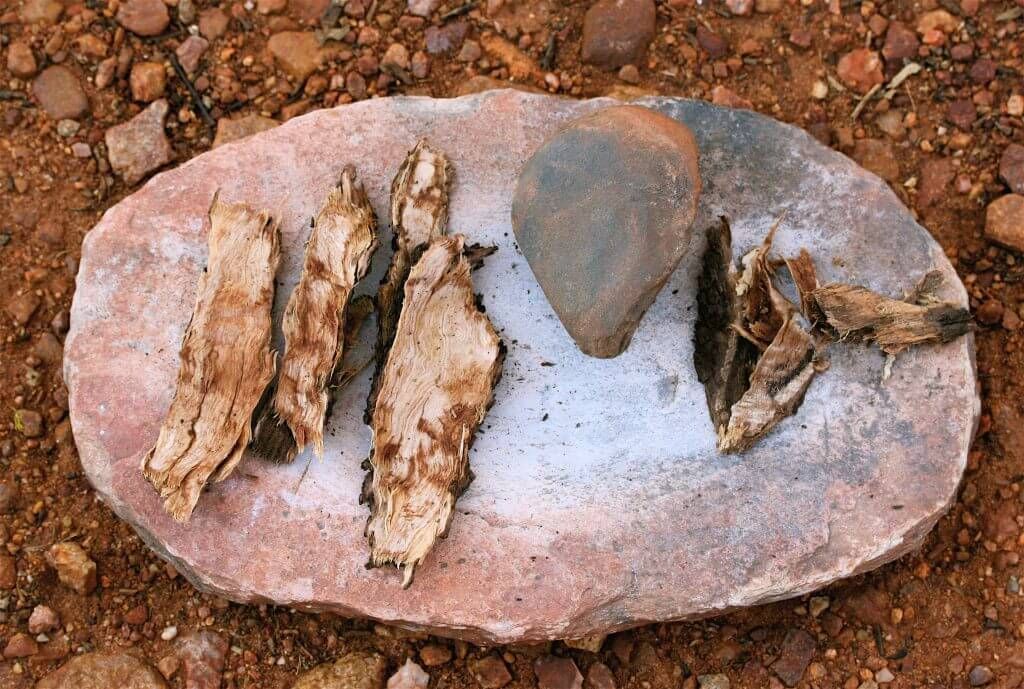
Many Noongar vegetable foods (maryn) were similarly cooked and ground to denature toxic or bitter substances as well as to soften the texture and to enhance the nutrient value.11 After cooking, the root bark was pounded between two grindstones. This pounding action was known as ‘yudang-winnan’ (Moore 1842: 83,107). The grinding stones usually consisted of a round or oval flattened basal stone that was larger than the upper stone (or muller) which was held in the right hand of the user for pounding and grinding. The left hand was used for squeezing and shaping the crushed bark into the form of a cake. Oldfield (1865: 278) describes the grinding process as follows:
‘…she proceeds to pound the roots singly, after each blow squeezing up the mass with her fingers of the left-hand, and thus continues pounding until the substance assumes the form of a coherent cake, about two inches in diameter and one-third in thickness.
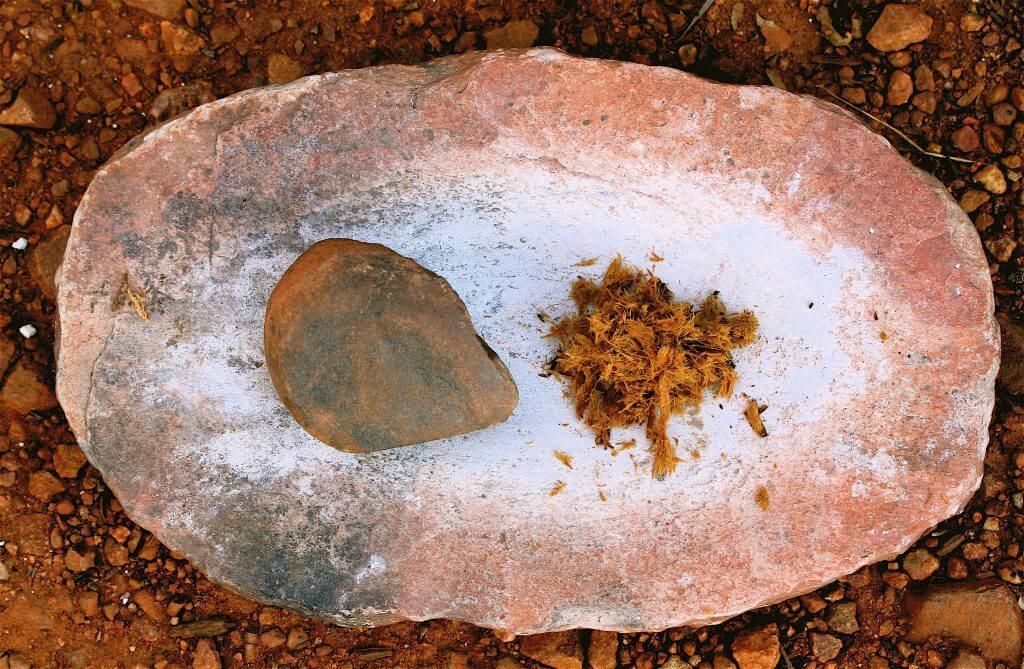
When Oldfield refers to cake, he is not referring to a cake in the European sense but rather a mixture that has been cooked, pounded and shaped ready for chewing.
Drummond (1839), Moore (1842), Ketoun (1849) and Salvado (1851) refer to Acacia gum as a key ingredient of root bark chew. Menna (or “manna” the colonial term for wattle gum) was a gum exudate collected from the trunks and branches of Acacia, especially A. microbotrya. 12 The gum exudate was the result of insect burrowing activities.
Acacia gum was often used as an additive when preparing vegetable foods, especially if they were acrid, woody or difficult to chew. It would have enhanced the taste and sweetness of the root bark.13 We would suggest that when the Acacia gum was mixed with root bark, the added mucilage from the gum would have formed a bulking agent which would not only have made the root bark easier to chew but also would have acted as a dietary filler, helping to provide a feeling of satiation. It would seem that root bark combined with Acacia gum was at certain times of the year used as a starvation food.
Ketoun (1849), in his diary entry dated 26th April 1844 refers to Aboriginal women bringing ‘some gum and “twotta” root’, among other things, to share with him. Two days later his diary entry reads:
‘Miserable night I passed; cold, hungry, and affected by the bad water. In the morning, before starting, the natives tightened their “nulbarns,” or belt; the natives procured some bark of the Twotta root, I masticated some and found it relieved my hunger. All this day we were kangaroo hunting but without success, and in the evening a little gum was all the food we had….”
To confirm whether the root bark from the York Gum could be used as a starvation food, we procured a sample in May 2008 from a friend’s property in Toodyay. Digging the root was difficult after such a long dry summer/autumn period. The first winter rains had not yet arrived. When the root bark was prepared in a (reconstructed) traditional manner of heating and grinding, it tasted sweetish and had a sticky texture. It was not unpleasant to chew, and a rough iodine test showed that it still contained a moderately high level of carbohydrate. Based on the early ethno-historical records such as those of Ketoun (1849) and our own experimentation with twotta root bark at different seasons, we would suggest that this substance was used not only as a confectionary but also as a starvation sustenance food.
The root bark would have been consumed primarily for its sugar content and, like the menna gum with which it was blended, it would have constituted a highly prized confectionery. Drummond (1843) draws attention to this when he describes the indigenous extraction of the saccharide content of the doatta root bark. 14
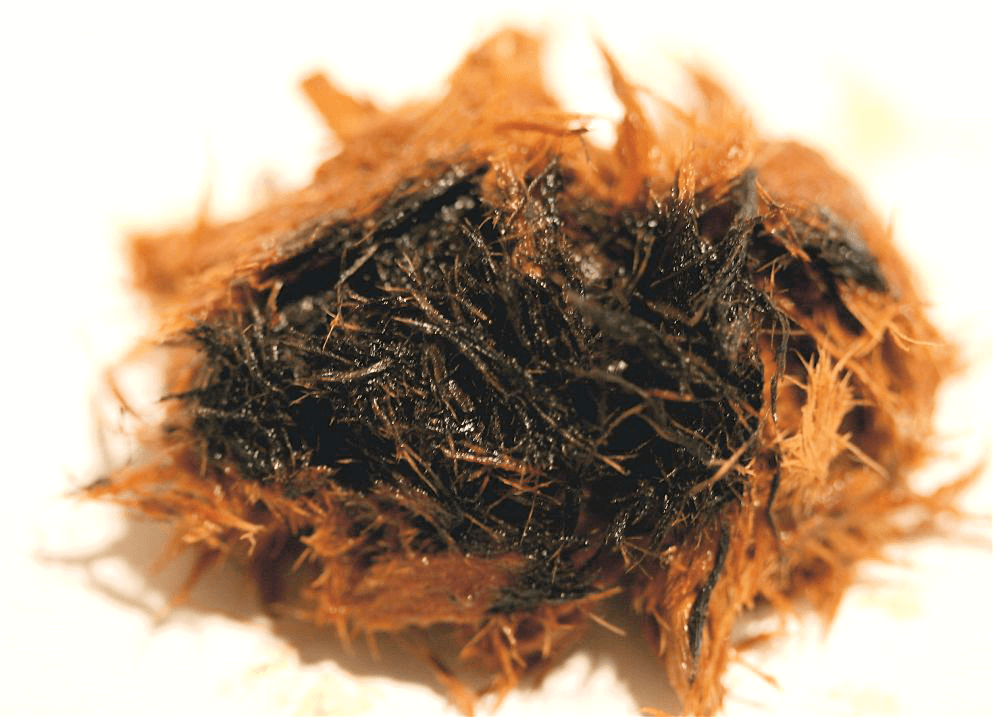
When Ken Macintyre tested the starch content of the root bark of Eucalyptus wandoo in October 2008 using an iodine test, he also found it to be high in carbohydrate. Its appearance and moist fibrous sticky texture (after cooking and pounding) closely resembled that of the root bark of Eucalyptus loxophleba (York gum). 15
Bates (1938) also comments on the sweet-tasting root bark of an unnamed species of mallee (this is possibly Eucalyptus diversifolia) that was given to her during her expedition to Eucla. 16 She records this edible root bark, known as nala, as one of the last true totems of the people of the Eucla region. 17 She states:
‘Dhalja brought me a wooden scoop filled with this edible bark… The bark was sweet and not unpalatable, and I returned the compliment in sugar, which he found sweeter still.’ (1938:127)
There is no doubt that Bates, like Drummond, was aware that this sweet food delicacy was a highly valued indigenous confectionery.
We would suggest that Bates is describing the very same bush food that Eyre (1841) and his Aboriginal informants subsisted on at one time in the Eucla region during their expedition across the Nullarbor plain heading towards King George Sound. His journal entry for April 6th states that:
‘the bark of the young roots of the gum-scrub. It appears to be extensively used for food by the natives in this district, judging from the remnants left at their encamping places. The bark is peeled off the young roots of the eucalyptus dumosa, put into hot ashes until nearly crisp, and then the dust being shaken off, it is pounded between two stones and ready for use. Upon being chewed, a farinaceous powder is imbibed from between the fibres of the bark, by no means unpleasant in flavour, but rather sweet, and resembling the taste of malt; how far a person could live upon this diet alone, I have no means of judging, but it certainly appeases the appetite, and is, I should suppose, nutritious.’
EXPLANATORY ENDNOTES
- The term Nyoongar can be rendered in a number of different ways. It can be spelt Noongar, Nyoongar, Nyoongah, Nyungar or Nyungah, depending on one’s personal or group preference. The literal translation of the term is ‘man’ or ‘people’. Today the term is used to denote indigenous people who originate from the southwest region of Western Australia. (It should be noted that “u” and ‘oo’ are interchangeable in Nyungar linguistics, both representing more-or-less the same sound).
- Drummond’s letter to W.J. Hooker, Director of Kew Gardens, London, is dated July 25th, 1839 and is written from Hawthornden Farm, Toodyay Valley.
- Drummond refers to the York Gum (Eucaplyptus loxophleba) as doalta (1839) or doatta (1843) or goatta (1843). The latter appears to be a typographical error in the transcription of Drummond’s original work. (It occurs on the same page as doatta referring to the York gum).
- Manna – References to manna gum or manna wattle in the ethnobotanical literature tend to refer to Acacia microbotrya (e.g. Meagher 197). The Nyungar terms for this sweet edible gum include menna or meen or men or the colonial name manna. The term manna is believed to derive from Arabic origins where mann denotes the exudation of the tamarisk. Other sources say that it has Latin or Greek derivations where it refers to the sweet secretion from the manna ash or similar plant. This would explain why early Western recorders referred to the sticky exudate eaten by the Nyungars as manna gum (1975: 21). Contemporary Elders often call it menna or sometimes ‘manna.’
- This reference by Drummond (1843) to root bark spit refuse to be seen around their bivouacs (camps) would suggest that the seasonal collection and preparation of this food was an organized form of food gathering rather than a sporadic opportunistic in-situ event. Like other seasonal foods duotta would have had a limited season.
- We would suggest that Stormon’s interpretation of Salvado’s duotta as tuart (Eucalyptus gomphocephala) is incorrect as tuart only grows in the coastal limestone belt and is not found inland at New Norcia where Salvado was stationed when writing about Aboriginal foods. The wandoo is known for its susceptibility to termite infestations and as a source of fresh water in the dry season. Salvado was probably describing wandoo.Salvado was not alone in referring to the white gum as duotta. Lyon (1833) and Madden (1848) also refer to “white gum” as dooto and doota, respectively. Others record white gum as wandoo, wornt or wando (Eucalyptus wandoo). In traditional Nyungar nomenclature it is not uncommon for a plant (or tree) to have more than one indigenous descriptor or referent term. References to ‘white gum’ in the early colonial accounts were often vague and general and had a wider application than today. The term broadly covered a number of Eucalypt species including tuart (Eucalyptus gomphocephala) and wandoo. This has created enormous confusion for contemporary researchers in their attempts to identify to species.The etymology of the term dwotta is uncertain. Salvado may provide a clue when he records totoran-an as meaning ‘to palpitate’ or ‘to beat.’ Could this be a reference to the rhythmic pounding motion in the preparation of root bark? Could totoran-an denote the importance of the beating or pounding of root bark prior to its consumption? In Nyungar plant nomenclature descriptors were often used to denote how a particular plant or plant product was identified, collected, prepared, consumed or otherwise utilised.
- Bird and Beeck (1988: 118-119) note that the root of the dward (York gum) was ‘chewed, mainly for medicinal purposes.’ This information appears to derive from their indigenous informants. Bird and Beeck (1988: 119) do not indicate the time of year when they collected and sampled the wandoo roots, and whether it was within the limited seasonal time frame of when this food was available.
- Salvado points out that duotta is collected from ‘the roots of certain types of trees.’ This suggests that more than one species of tree was used. It is our opinion that the term twotta (or its variants dwotta, duatta, duotta, etc) collectively refers to the edible root bark of several species of Eucalyptus. The term tda (ta or da) means ‘mouth’ or ‘to eat.’
- Menna does not apply only to the gum of Acacia microbotrya (‘manna wattle’). It also describes the edible gum of acuminata (‘jam wattle’) and A. saligna (‘black wattle’). Menna is recorded by Moore (1842:100) as the gum of the jam Acacia while meen is recorded by Hassell (1975: 19, 232) as the edible gum of the black wattle (presumably A. saligna). Thus Menna is a collective term that denotes the sweet edible gum of several species of Acacia. For further information on menna gum, also known by Nyoongars as galyang, see Macintyre and Dobson 2014 ‘Notes on Indigenous Confectionery,’ forthcoming).
- The wanna was commonly used by women for digging. A woman’s wanna often accompanied her to the grave. As stated by Nind (1831:47): ‘When a female is interred, her implements are, in like manner, deposited in her grave.’
- It is highly probable that the root bark was cooked in wood-ash as this would have neutralised or reduced the bitterness associated with any tannins or saponins contained within the bark.
- Macintyre suggests that Acacia gum was added as an ingredient to the root bark mixture to counter any residual tannins and to add mucilage to make it easier to chew. It possibly also enhanced the sweetness quality.
- This is highlighted by Edward Wilson Landor who based in York, Western Australia in the 1850’s refers, in his journal detailing his experiences in the new colony, to Drummond’s descriptions of indigenous foods (formerly published in the Inquirer). Landor states that doatta is ‘a species of this class, [‘Eucalyptus tribe’] and the bark of its root is much relished by the natives, having a sweet and pleasing taste….’ Chapter 28. The Bushman: Life in a New Country. By E.W. Landor. The Project Gutenberg E-Book.
- Macintyre suggests that root bark may have been preferred to trunk bark for practical reasons in that it is easier to procure and remove than the trunk bark. Also it is potentially less damaging to the tree to remove the root bark. The partially exposed lateral ground roots of York gum and Wandoo are easily accessed and the younger roots may have been preferred due to their tenderness and lower tannin content.
- The particular species of mallee is not named or identified by Bates but like all totems it would have been common to the area. There are many Mallee species found in the Eucla region. These include Eucalyptus calcareana (Nundroo mallee) and Eucalyptus oleosa (Red mallee)
- In 1913 during an expedition to Eucla (the easternmost point in Western Australia close to the border with South Australia) Bates observes the last initiation ceremony held in the region. She meets a group of local men whose totem was the edible root bark (nala). She states:
‘There were a few whose connections had been the Eucla people, the last holder of the two true totems, the wild currant (ngoora), and nala (the edible bark of the root of a species of mallee)’. (Bates 1938: 120) - Although Bates is not referring to Nyungar culture, it is interesting that she records nala as one of the last ‘true’ totems of the people of the Eucla region. She comments that it has a ‘sweet’ taste but implies that it is somewhat mild when compared to the intense sweetness of the processed sugar that she offers them in return. Her quote lends support to the view that taste buds are culturally determined or acquired and that sweetness is culturally relative depending on the array of foods to which a particular group is accustomed.Bates seems aware that the root bark offered to her by Dhalja was considered by them to be a highly valued sweet delicacy. Her return gift of refined sugar would have had a profound effect and possibly would have contributed to the decline of the potency of nala, the root bark totem.
BIBILOGRAPHY
Bates, D. 1938 The Passing of the Aborigines: A Lifetime spent among the Natives of Australia. London: John Murray.
Bates, D. 1985. The Native Tribes of Western Australia. Isobel White (Ed.). Canberra: National Library of Australia,
Bates, Daisy 1992 Aboriginal Perth: Bibbulmun Biographies and Legends. Peter J. Bridge (Ed.) Carlisle, Perth: Hesperian Press.
Bindon, P. and R. Chadwick (eds.) 1992 A Nyoongar Wordlist from the South-West of Western Australia. WA Museum, Anthropology Department.
Bindon, P. 1996 Useful Bush Plants. Perth: Western Australian Museum.
Bird, C.F.M. and Beeck, C. 1988. Traditional Plant Foods in the Southwest of Western Australia: The Evidence From Salvage Ethnography. In: Meehan, B. and Jones, R. (Eds.). Archaeology with Ethnography: An Australian Perspective. School of Pacific Studies, Australian National University: Canberra.
Bunbury, W. St. P. and Morrell, W.P. (eds.) 1930 Early days in Western Australia, being the letters and journal of Lieut. H.W. Bunbury, 21st Fusiliers. London: Oxford University Press.
Curr, E.M. The Australian Race: Its origin, languages, customs, place of landing in Australia, and the routes by which it spread itself over that continent. Vols 1 & 11. Melbourne: Government Printer.
Drummond, J. 1839 Letter to Sir William Hooker, Kew Gardens, London. July 25th
Drummond, J. 1843 Letter No. 15 to the Inquirer, 22nd March.
Green, N. 1979 (Ed.) Nyungar – The People: Aboriginal customs in the southwest of Australia. Mt Lawley, North Perth: Creative Research Publishers.
Grey, G. 1840 A Vocabulary of the Dialects of Southwestern Australia. 2nd edition. London: T & W Boone.
Grey, G. 1841 Journals of Two Expeditions of Discovery in North-West and Western Australia during the years 1837, 38 and 39. Volume 1.
Hassell, Ethel 1975 My Dusky Friends: Aboriginal life, customs and legends and glimpses of station life at Jarramungup in the 1880’s. East Fremantle: C.W. Hassell
‘Ketoun’, 1849 ‘A Trip to the Wong-an Hills, Stray leaves from my Note Book.’ The Perth Gazette and Independent Journal of Politics and News, Friday 1 June.
Landor, E.W. 1847 The Bushman, or, Life in a New Country. London: Richard Bentley.
Lyon, R.M. 1833 ‘A Glance at the Manners, and Language of the Aboriginal Inhabitants of Western Australia; with a short vocabulary’. In N. Green (Ed.) Nyungar – The People: Aboriginal customs in the southwest of Australia. North Perth: Creative Research Publishers.
Macintyre, K. and Dobson, B. 2014 ‘Notes on traditional Nyungar taxonomy and nomenclature,’ (forthcoming).
Macintyre, K. and Dobson, B. 2014 ‘Notes on Indigenous Confectionery’ (forthcoming).
Madden, R.R. 1848 Vocabulary of the Aborigines, Perth Tribe Dialect (microfilm). Battye Library, Perth, Western Australia.
Meagher, S. J. 1974. The Food Resources of the Aborigines of the Southwest of Western Australia. Records of the Western Australian Museum, 3:14-65.
Moore, G.F. 1842. A Descriptive Vocabulary of the Language in Common Use Amongst the Aborigines of Western Australia. London: Orr.
Moore, G.F. 1884. Diary of Ten Years of Eventful Life of an Early Settler in Western Australia. London: M. Walbrook.
Nind, Scott 1831 Description of the Natives of King George’s Sound (Swan River Colony) and adjoining country. The Journal of the Royal Geographical Society of London, Vol 1, pp. 21-51.
Oldfield, Augustus 1865 ‘On the Aborigines of Australia.’ Read on February 9th 1864. Published in Transactions of the Ethnological Society of London, vol.3 1865, pp. 215-298.
Roe, J.S. 1835 ‘Journal of an Expedition from King Georges Sound, overland to Swan River, via York.’ In Shoobert, J. 2005 Western Australian Exploration, 1826-1835 Vol 1. Victoria Park, Perth: Hesperian Press.
Shoobert (ed.) 2005 Western Australian Exploration 1826-1835, The Letters, Reports & Journals of Exploration and Discovery in Western Australia. Vol 1, Victoria Park: Hesperian Press.
Salvado, R. 1851 in Storman, E.J. 1977 The Salvado Memoirs. Nedlands: University of Western Australia Press.
Stormon E. J. 1977 The Salvado Memoirs. Nedlands: University of WA Press.
White, I. (Ed.) 1985. The Native Tribes of Western Australia. Canberra: National Library of Australia.
